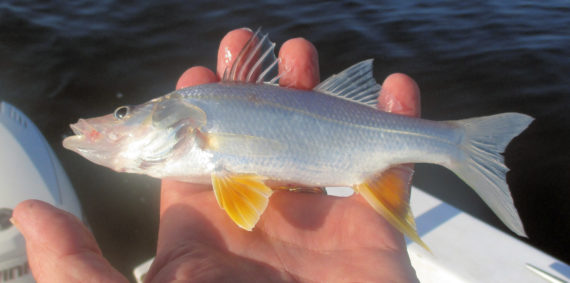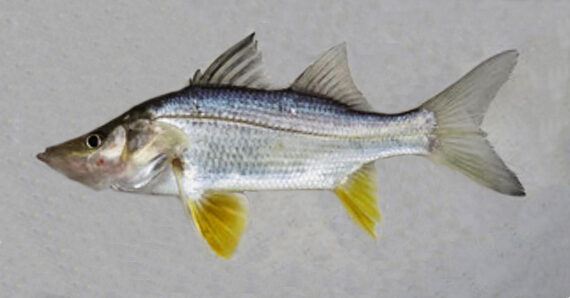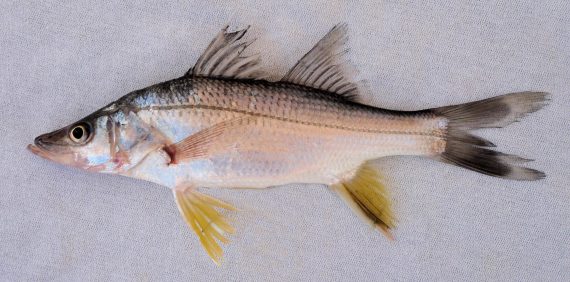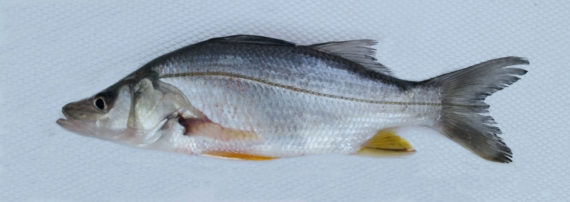Yellowfin Snook, Centropomus robalito
 Yellowfin Snook, Centropomus robalito, Juvenile. Fish caught from coastal waters off Mazatlán, Sinaloa, October 2016. Length: 14 cm (5.5 inches). Catch, photograph and identification courtesy of George Brinkman, Guelph, Ontario, Canada.
Yellowfin Snook, Centropomus robalito, Juvenile. Fish caught from coastal waters off Mazatlán, Sinaloa, October 2016. Length: 14 cm (5.5 inches). Catch, photograph and identification courtesy of George Brinkman, Guelph, Ontario, Canada.
 Yellowfin Snook, Centropomus robalito. Fish caught from coastal waters off Mazatlán, Sinaloa, October 2016. Length: 23 cm (9.1 inches). Catch, photograph and identification courtesy of Eli (obsessiveangling.wordpress.com).
Yellowfin Snook, Centropomus robalito. Fish caught from coastal waters off Mazatlán, Sinaloa, October 2016. Length: 23 cm (9.1 inches). Catch, photograph and identification courtesy of Eli (obsessiveangling.wordpress.com).
 Yellowfin Snook, Centropomus robalito. Fish caught out of the San José River, Baja California Sur, with a Cast Net during a breach in the barrier, January 2011. Length: 26 cm (10 inches).
Yellowfin Snook, Centropomus robalito. Fish caught out of the San José River, Baja California Sur, with a Cast Net during a breach in the barrier, January 2011. Length: 26 cm (10 inches).
 Yellowfin Snook, Centropomus robalito. Fish provided by commercial bait salesmen Loreto, Baja California Sur, June 2018. Length: 29 cm (11 inches). Photograph courtesy of Chris Wheaton, Fullerton, California.
Yellowfin Snook, Centropomus robalito. Fish provided by commercial bait salesmen Loreto, Baja California Sur, June 2018. Length: 29 cm (11 inches). Photograph courtesy of Chris Wheaton, Fullerton, California.
The Yellowfin Snook, Centropomus robalito, is a member of the Snook or Centropomidae Family, that is also known as the Little Snook, and in Mexico as robalo aleta amarilla or simiply roballo. Globally, there are twelve species in the genus Centropomus, and all twelve are found in Mexican waters, six in the Atlantic and six in the Pacific Ocean.
The Yellowfin Snook has an oblong elongated compressed body. They are silvery fish with a prominent dark lateral line. Their anal and pelvic fins are yellow; their caudal, dorsal, and pectoral fins are dusky with tinges of black (their pectoral fins also have a black base). They have a straight to slightly concave shovel-shaped upper head profile, a large protractile terminal mouth, and a protruding lower jaw. Their anal fin has 3 spines, the second is thick and much longer than the third, and 6 or 7 rays; the caudal fin is forked, their first dorsal fin has 8 spines, their second dorsal fin has 1 spine and 9 to 11 rays; their pectoral fins have 14 to 16 rays and are very short; and their pelvic fins have 1 spine and 5 rays and are a little behind the pectoral fin base. They have 26 to 31 gill rakers on the first arch. They are covered with scales.
The Yellowfin Snook is found in bays, estuaries, the lower parts of freshwater streams, and where dry river beds meet the ocean (presumably due to subterranean water flow) at depths up to 80 feet. They reach a maximum of 35 cm (14 inches) in length and 1 kg (2 lbs 3 oz) in weight. The Yellowfin Snook is poorly studied with very limited information available about their lifestyle and behavioral patterns including specific details on age, growth, longevity, movement patterns, diet, habitat use, and reproduction.
The Yellowfin Snook is a resident of Mexican waters of the Pacific Ocean but has a very limited distribution being found from Loreto, Baja California Sur, southward along the southeast coast to Cabo San Lucas with the southern boundary established by the fish pictured above in the southern half of the Sea of Cortez, and along the coast of the mainland south to Guatemala. They are more abundant in the southern portions of the range.
The Yellowfin Snook cannot be confused with any other species due to its very thick and long second anal fin spine.
From a conservation perspective the Yellowfin Snook is currently considered to be of Least Concern with stable, widely distributed populations. They are exceedingly rare and thus of limited interest to most. If available, they are considered to be an excellent food fish.